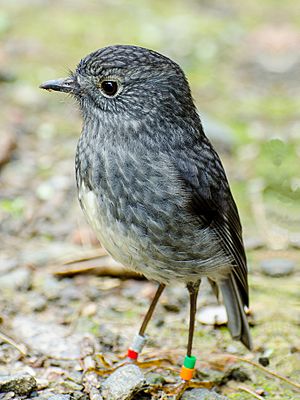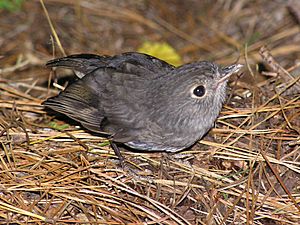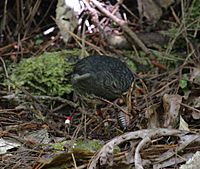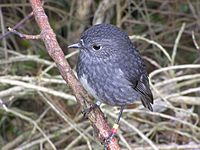North Island robin facts for kids
Quick facts for kids North Island robin |
|
|---|---|
 |
|
| Conservation status | |
| Scientific classification | |
| Genus: |
Petroica
|
| Species: |
longipes
|
The North Island robin (Petroica longipes) is a small bird that lives only on the North Island of New Zealand. When a plant or animal lives only in one place, it is called endemic. This robin is a type of Australasian robin.
It is closely related to the South Island robin (P. australis), which lives on the South Island and Stewart Island. For a long time, people thought they were the same species. But scientists looked at their mitochondrial DNA (a special part of their cells). They found that these two groups of robins separated a very long time ago, even before the Pleistocene Ice Age. This means they are now considered two different species.
Contents
What the North Island Robin Looks Like
The North Island robin has feathers that are mostly dark grey-black. It has a lighter patch on its belly and chest. This light area is smaller than the one on the South Island robin. You might also see some pale streaks on its back feathers.
Male and female robins look a bit different. This is called sexual dimorphism. Male robins usually have darker feathers than females. They are also a little bit bigger.
Where North Island Robins Live
North Island robins are found mostly in the middle of the North Island. There are also smaller groups in the north and south. You can find them on islands like Moturua Island (in the Bay of Islands), Little Barrier Island, and Kapiti Island.
Some groups of robins have been moved to new safe places. For example, they now live in the Zealandia sanctuary in Wellington. They also live at Moehau on the Coromandel Peninsula. Another group is growing in the Ōhope Scenic Reserve, near Whakatāne. About 40 birds were moved there from Mokoia Island to help the population grow.
These robins prefer to live in native forests. They especially like forests with Podocarpus trees and southern beech trees (Nothofagaceae). They can live in these forests from sea level all the way up to the tree-line.
How North Island Robins Find Food
Hunting for Food
The North Island robin looks for its food on or near the ground. This is different from the tomtit, which is a related bird that often hunts in trees. Robins find their food in a few ways:
- Perch-hunting: They sit on a high branch and wait. When they spot something moving below, they quickly fly down to catch it.
- Active searching: They walk around and look for food.
They find their prey in leaf litter on the forest floor. They also look in low plants, on branches, and even on tree trunks.
What They Eat
North Island robins eat many different small creatures. These include invertebrates like cicadas, earthworms, wētā (a type of large insect), snails, and spiders. They also eat some fruit.
When there is a lot of food, North Island robins will hide some for later. This is called caching food. Male robins tend to hide more food than females. Both male and female robins might try to steal food from their mate's hidden stash. They are less likely to hide food if their mate is nearby.
See also
 In Spanish: Petroica de la isla Norte para niños
In Spanish: Petroica de la isla Norte para niños





